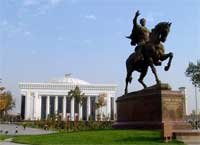September 5, 2014
80.8% of Uzbekistan’s GDP produced in the private sector2
Refinement and Magnificence of Asian Splendour3
Session of the Executive Council of the UN World Tourism Organization (UNWTO)4
Samarkand – the capital of the 99th Session of the UNWTO.. 4
economy
80.8% of Uzbekistan’s GDP produced in the private sector
According to official statistics, in the first half of 2014 major share of gross domestic product, which is 80,8% was produced in the private sector. Accordingly, 19.2% in the structure of GDP accounted for the public sector.
In the structure of private property in the period under consideration, the largest share was the property of citizens – 32.1%. The share of the property of business associations amounted to 28.8%, enterprises with participation of foreign capital – 4.4%, other types of private property – 3.3%, property of farms – 2.2%.
In the sectoral structure of GDP in the first half of 2014 production services occupied the major share of 52.7%. The production of goods amounted to 35.7%, and net taxes on products and export-import operations – 11.6%.
Recall that the volume of the gross domestic product of Uzbekistan in January-June of 2014, according to preliminary estimates, amounted to 61056.1 bln. soums in current prices, growth in comparison with January-June 2013 – 8.1%.
(Source: UzReport.uz)
Society
History in Books
On the threshold of the 23rd anniversary of independence of Uzbekistan, the Institute of History of the Academy of Sciences has published another book of the series entitled ‘The History of Uzbekistan’.
The publication of the series of academic books entitled ‘The History of Uzbekistan’ is a large-scale joint project of scientists of the Institute of History, the Institute of Archaeology, Coordination and Methodological Center on the Recent History of Uzbekistan and other research centers of the country. In consequence, a multi-volume edition covering all the periods of the history of Uzbekistan, will appear. The books on the periods of the 16th and first half of the 19th centuries, as well as the period of 1917-1991, and recent history have already been published.
A press proof of another volume on the second half of the 19th and the early 20th centuries has been published. A large-scale distribution will be carried out after the book is modified considering suggestions and notes made by leading scientists and specialists.
As for the details of the project, deputy director of the Institute of History of the Academy of Sciences of Uzbekistan, candidate of historical science Shuhrat Muhammedov reflected thus:
“The previous similar edition was released in 1969. It consisted of four volumes. Over the years, a lot of events have happened, and new historical materials have been discovered and studied. So, we have needed a new multi-volume edition for a long time. The book is intended for historians, professionals, students and anyone who is interested in history.”
The new books were published on the basis of new historical materials. In contrast to the previous edition, the books focus on the ethnographic process, the peculiarities of the working and living conditions of the people in various fields, the social composition of the population, and the role of various initiations in the industrial life of the country.
It is noteworthy that team of authors consisting of ten to fifteen professionals is working on each volume. All the chapters are distributed among scientists to work on according to their specialization. This resulted in a high level of authenticity and impartiality of the citation of facts. Through the books scientists attempt to cover all their points of view on each event dating back to different times and taking place in different countries.
(Source: «Uzbekistan Today» newspaper)
art
Refinement and Magnificence of Asian Splendour
Zarduzi, the art of making embroidery with gold thread has existed in the territory of Uzbekistan since very ancient times. The well-known paintings in the palaces of Balalyktepa, Varakhsha and Afrasiab (6th-8th centuries) are clear evidence of this, depicting people dressed in clothes decorated with goldwork.
Ruy Gonzalez de Clavijo, the Spanish ambassador to Tamerlane’s court in 1403-1406, wrote in his diary that the ruler’s wife Saray-Mulk-Khanum wore dresses embroidered with gold thread.
The ancient traditions of goldwork survived to the late 19th century. Bukharian artisans created an original style, which had no analogies in technique, composition or ornamentation.
‘History of Bukhara’ written by 10th-century historian Narshakhi is the first scientific work that mentioned the Bukhara goldwork. Unfortunately, ancient samples of embroidery have not survived to our days. We can judge about it only by museum exhibits belonging to the 19th century.
Ceremonial clothes, headdresses and shoes were decorated with gold embroidery. It is curious that only men were engaged in the craft of goldwork. The knowledge was passed from father to son.
In the 20th century the art of gold embroidery spread beyond the borders of the Emirate of Bukhara. At that time the production of goldwork items also began in Samarkand, Urgut, Tashkent, Gijduvan, and other cities and towns. Gold embroidery became highly popular worldwide due to its refined patterns, complex technique and fantastic images. Nowadays usually women work in this craft. As it was many years ago, they stitch items manually, making them lush and rich in their own way. A skullcap or suzani, shoes or a robe – each thing is a real work of art.
Beautiful samples of clothes and other domestic items decorated with gold embroidery can be found among exhibits in a number of state museums of Uzbekistan, such as the State Museum of History, State Museum of Arts, Museum of Applied Arts, State Museum of the Timurid History and others. The Bukhara State Museum of Art and Architecture also has a rich collection of items decorated with goldwork.
Ceremonial robes from Bukhara embroidered with gold, zarchopon, strike one’s imagination with their decorative and ornamental diversity: there is not a pair of identical robes. In former times emirs and court aristocracy wore such robes. There were also ceremonial robes which were among items presented to ambassadors or royal aristocracy as a token of favour. Today, as the national traditions and people’s crafts are being revived, men’s robes decorated with goldwork have become an indispensable part of a bridegroom’s wedding costume; they are also worn at other important ceremonies and are presented to respected guests…
The principal thread used by embroidery masters is kalebatun, thin strips of metal wound around a core of silk or paper. Apart from metal threads artisans use coloured twisted or plain silk, applications from velvet and silk and relief rosettes called kubba or kubba olmasi made of gold threads and imitating golden embellishments.
Embroidery is usually made on dark velvet: cherry, blue, purple or crimson. The soft depth of velvet makes the ornamentation of gold embroidery more picturesque. The structure of material, the embroidering technique and the structure, the decoration and colour of ornamentation complement each other producing a uniform harmonious image.
Many generations of masters have designed and developed the unique gold embroidering technique. Two principal sewing methods are used: zarduzi-zaminduzi (solid) and zarduzi-gulduzi (floral).
The zarduzi-zaminduzi technique consists in covering the background with laid yarn of gilded silver; the couching gold thread is stitched onto the laid thin laces.
The zarduzi-gulduzi method was developed in the early 20th century. The elements of a pattern are cut from thick paper, cardboard or sometimes leather, applied on cloth stretched tight on tambours, fixed and sewn around with gold or silver thread. Drawings are made by specialists called tarkhkash. They draw elements of patterns on paper and transfer them onto cardboard with the help of a pounce and cut them with special scissors. Then individual elements of the composition are applied to the fabric and all this is passed to the embroiderer.
For many centuries three principal types of composition have formed in the art of gold embroidery: daukur, butador and darkham.
The ornamented gold fringe kur serves as the base in the daukur composition.
The principal features of butador are floral or other patterns covering all of the central field and placed at some distance from each other.
The darkham composition consists of a continuous pattern placed in the central field. The contours in this composition are embroidered with the use of the takhrir technique, consisting in bordering the main pattern with a thin lace made of twisted gold threads or the kobuli (Kabul sewing) technique – with threads in the form of small round loops connected with each other.
The bordering fringe inherent in clothes and large-scale decorative items is decorated on both sides with narrow festooned strips called obi poncha.
Gold embroidered patterns on items are quite diverse. Plant forms and motifs are composed of flowers, stems, leaves and fruits, twisting, bending or swirling in a kind of rythm. Irises, pinks, tulips, crests, gentle apple flowers. Pomegranates, cherries, almonds and peppers. Stylised abundance, meaningful symbolism.
Plants symbolise an appeal to the nature for strength, health and wealth. Making up complex compositions an artisan wished wellbeing to a person looking at them. If one knew their symbolism, they realised the meaning of the compositions at the first sight. For instance, irises in the ornamental motifs of embroidery symbolise calmness and long life, the wavy stem of the convolvulus – wealth and tenacity of life; buds and leaves express the idea of fertility and nature’s spring revival. Almond-like motif bodom means fecundity. The thinner and more elongated forms of the almond serve as an amulet and are known under the name of kalampir (capsicum). Wavy and streaming patterns embody life-bearing water.
Ornaments in the form of circles, rhombi and broken lines are not used very often.
Calligraphic religious inscriptions in gold embroidery are accomplished with great taste and are placed at the borders of certain compositions.
Skullcaps ornamented with goldwork produced in Bukhara are very popular among tourists. Only smooth velvet of various colours (violet, green, blue and black) is used in their production. Artisans from Bukhara use mainly botanical motifs: bodom (almond), turunj (hesperidium), rosettes, palmettos, geometric figures (circles, rhombi and others). There are also epigraphic ornaments. Fine combinations of blue, grey and crimson make patterns on Bukharian embroideries particularly accentuated and beautiful.
The contemporary art of goldwork inherited a wide range of ornamental motifs distinguished by diversity and bright decoration. Today artisans’ task is to use this rich artistic heritage, some part of which is kept at museums, and create new beautiful images.
(Source: «Uzbekistan airways» magazine)
Session of the Executive Council of the UN World Tourism  Organization (UNWTO)
Organization (UNWTO)
Samarkand – the capital of the 99th Session of the UNWTO
A few days ago, the Executive Council of the World Tourism Organization (UNWTO) voted in favor of conducting the 99th meeting in Samarkand (Uzbekistan), reports the press service of NC “Uzbektourism”.
The decision was made in the framework of the 98th session of the UNWTO, which took place in the city of Santiago de Compostela(Spain), 4-6 June 2014. Choice of the next venue for the meeting was held by an open vote of the Executive Board. All participants in the meeting voted in favor of Samarkand.
Note that the decision of the earlier selection of Samarkand as a venue of the next UNWTO session was announced by Executive Director Zoltan Somogy at the International Tourism Fair ITB-Berlin2014.
Holding the 99th session of the UNWTO in Uzbekistan, in ancient Samarqand, is an important event for the entire region. Let us recall that 20 years ago Samarkand Declaration of member countries of the international project development of tourism along the Silk Road was adopted.
Since 2004, the Office of the UNWTO operates in Samarkand.
(Source: IA “Jahon”)
Reference to the source is a must in reproducing materials





















